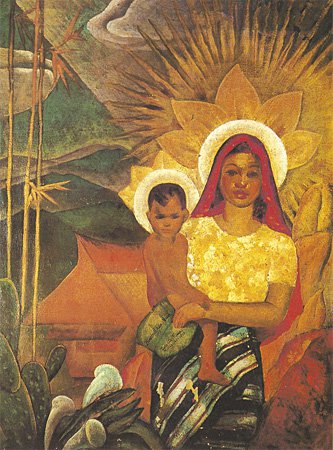Cultural Center of the Philippines
ENCYCLOPEDIA OF
PHILIPPINE ART
Brown Madonna
1938 / Oil on canvas / 62 x 47 centimetres / Artist: Galo B. Ocampo / University of Santo Tomas Museum Collection
With Victorio Edades and Carlos Francisco aka Botong, Ocampo formed the triumvirate that spearheaded the struggle for modern art in the country. Brown Madonna is one of his successful prewar works marked by the quest for a Philippine modernist idiom.
Several aspects of the work show its break with the past. In terms of subject, Ocampo’s representation of the madonna-and-child departs from traditional colonial iconography, which gave a Caucasian cast to the holy figures. Here the brown complexion and features identify the figures as Filipino. Mary’s baro’t saya and tapis are unmistakably rural Filipino. The background is tropical, with its bamboos and mountains allusive of rice terraces, and the thatched hut in the lower section. The artwork may be viewed as one of the first efforts in painting to create new Filipino icons with which the people could identify, thus comprising an attempt at decolonization of religious imagery. Aside from nationalism, the motive for indigenization could also have come from the French post-impressionist Paul Gauguin’s Tahitian work La Orana Maria, 1891. Ocampo’s style is likewise modernist in the use of bright colors, the flat decorative effect, the absence of linear perspective, and the use of spatial recession as depth.
Written by Alice G. Guillermo (1994)
